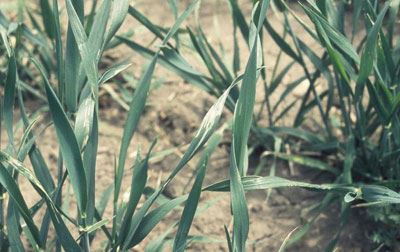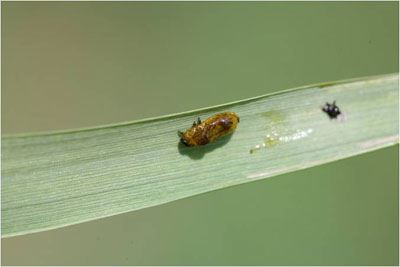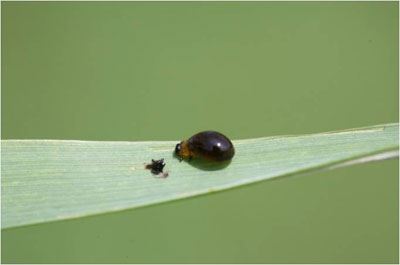Cereal Leaf Beetle Spotted In Southern Missouri Wheat Fields
COLUMBIA, MO.
Cereal leaf beetle has been found on both sides of the state in southern Missouri. Cereal leaf beetle strips the leaves of wheat and can reduce yields.
Wheat growers should scout fields for the beetle, said Wayne Bailey, University of Missouri Extension entomologist. The threshold amount is one larva per stem. Infestation can be spotty, so Bailey recommends checking individual fields regularly.

Wheat damaged by cereal leaf beetle.
Photo credit: MU Extension
Larvae hinder photosynthesis in wheat by stripping the chlorophyll-filled green tissue between veins on the flag leaf, the last leaf to emerge from the whorl. Leaves appear to have white striping after being stripped. Severely infested fields may look like they are frost-covered.

Larvae of the cereal leaf beetle strip the green matter between the veins of wheat's flag leaf, disrupting photosynthesis.
Photo credit: Bob Hammon, Colorado State University, Bugwood.org
Larvae are white or yellow, and have a black head and six small legs. They throw slimy fecal material over their back to deter predators. As a result, they may appear to be black, rather than yellow or white.

The cereal beetle appears to be shiny and black because it throws slimy excrement over its back to ward off predators.
The beetle, which can reduce wheat yields by stripping the flag leaf, has been spotted in southern Missouri.
Photo credit: MU Extension
After walking in infested fields, farmers may find their clothing is spotted with material that looks like bird droppings.
Usually, the cereal leaf beetle appears after a dry spring, but that is not the case this year, Bailey said. The beetle first appeared in Missouri in 1972 and usually is more prevalent in northern states.
Bailey recommends frequent scouting of fields, and insecticide use if yield loss warrants the cost of product and application.
Damage to the flag leaf can reduce yields significantly because the flag leaf determines grain fill, Bailey said. ∆